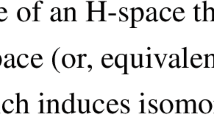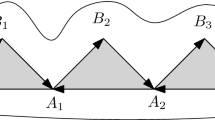Abstract
This paper presents two algorithms. The first decides the existence of a pointed homotopy between given simplicial maps \(f {},\,g:X\rightarrow Y\), and the second computes the group \([\varSigma X,Y]^*\) of pointed homotopy classes of maps from a suspension; in both cases, the target Y is assumed simply connected. More generally, these algorithms work relative to \(A\subseteq X\).
Similar content being viewed by others
Notes
For non-oriented bundles, the \(\mathbb {Z}/2\)-equivariant version of our theorem would be needed for the target space BO(k); such an extension is briefly mentioned later.
An extension to non-free actions is a work in progress by the authors of this paper.
In the non-relative setup, i.e., for \(A = \emptyset \), the set \([X, {P_{n}}]\) always contains the homotopy class of the constant map. The question whether this is the only homotopy class, i.e., whether \([X, {P_{n}}]\) has a single element, is a problem whose decidability is an open question.
To give a rough idea, the effective homology of a space X consists of a computable chain homotopy equivalence \(C_*X \simeq C_*^\mathrm {ef}X\), i.e., there are algorithms computing chain maps in both directions and algorithms computing chain homotopies; the crucial requirement is that, in each dimension, \(C_*^\mathrm {ef}X\) should be a finitely generated abelian group. In this way, one may compute within this chain complex effectively and thus, using the provided chain homotopy equivalence, also within \(C_*X\), at least on homological level.
Of course, finite simplicial sets are easily provided with effective homology, since the identity on \(C_*X\) is sufficient, but many infinite simplicial sets also admit effective homology, e.g., the Eilenberg–MacLane spaces \(K(\pi , n)\). The strength of the notion of effective homology lies in the fact that many constructions with spaces can be also performed on the level of effective homology, so that, for example, a (twisted) Cartesian product of spaces with effective homology is again a space with effective homology.
References
E. H. Brown. Finite computability of Postnikov complexes. Ann. Math. 65 (1957), 1–20.
M. Čadek, M. Krčál, J. Matoušek, F. Sergeraert, L. Vokřínek, U. Wagner. Computing all maps into a sphere. J. ACM 61 (2014), 17:1–44.
M. Čadek, M. Krčál, J. Matoušek, L. Vokřínek, U. Wagner. Extendability of continuous maps is undecidable. Discr. Comput. Geom. 51 (2014), 24–66.
M. Čadek, M. Krčál, J. Matoušek, L. Vokřínek, U. Wagner. Polynomial-time computation of homotopy groups and Postnikov systems in fixed dimension. SIAM J. Comput. 43 (2014), 1728–1780.
M. Čadek, M. Krčál, L. Vokřínek. Algorithmic solvability of the lifting-extension problem. In: Discr. Comput. Geom. 57 (2017), pp. 915–965.
B. Eick, M. Horn, W. Nickel. Manual for the polycyclic package in GAP. https://www.gap-system.org/Manuals/pkg/polycyclic-2.11/doc/manual.pdf, (2013). Accessed 6 May 2019.
V. Gebhardt. Magma Handbook, Polycyclic groups. https://magma.maths.usyd.edu.au/magma/handbook/polycyclic_groups. Accessed 6 May 2019.
P. S. Novikov. On the algorithmic unsolvability of the word problem in group theory (in Russian). Trudy Mat. Inst. im. Steklova 44 (1955), 1–143.
J. P. May. Simplicial Objects in Algebraic Topology. University of Chicago Press, Chicago, IL, (1992).
J. Rubio, F. Sergeraert. Constructive homological algebra and applications. Preprint, arXiv:1208.3816, 2012. Written in 2006 for a MAP Summer School at the University of Genova.
C. C. Sims. Computation with Finitely Presented Groups. Cambridge University Press, Cambridge, (1994).
A. Storjohann. Near optimal algorithms for computing Smith normal forms of integer matrices. In Proceedings of the 1996 international symposium on Symbolic and algebraic computation, ACM, pp. 267–274
Author information
Authors and Affiliations
Corresponding author
Additional information
Communicated by Shmuel Weinberger.
Publisher's Note
Springer Nature remains neutral with regard to jurisdictional claims in published maps and institutional affiliations.
Research of MF was supported by the Austrian Science Fund (FWF Project P31312-N35). Research of LV was supported by the Center of Excellence – Eduard Čech Institute (Project P201/12/G028 of GA ČR).
Rights and permissions
About this article
Cite this article
Filakovský, M., Vokřínek, L. Are Two Given Maps Homotopic? An Algorithmic Viewpoint. Found Comput Math 20, 311–330 (2020). https://doi.org/10.1007/s10208-019-09419-x
Received:
Revised:
Accepted:
Published:
Issue Date:
DOI: https://doi.org/10.1007/s10208-019-09419-x




